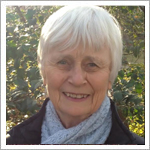Q&A about natural spaces for children
By Peggy Ashbrook
Posted on 2014-06-15
 It was a perfect early summer day with temperatures in the low 70s (F) and a gentle breeze that make it easy to be outdoors for hours. We had a combination of shade, sunscreen or hats to protect from the sun’s ultraviolet radiation and a pitcher of water to drink when thirsty. And we had a play space that engaged the children in running after each other, digging and moving sand, climbing in the low trunks of a shrub-y tree, and swinging on the tire swing. It was a perfect day to reflect on what elements make a successful outdoor play space.
It was a perfect early summer day with temperatures in the low 70s (F) and a gentle breeze that make it easy to be outdoors for hours. We had a combination of shade, sunscreen or hats to protect from the sun’s ultraviolet radiation and a pitcher of water to drink when thirsty. And we had a play space that engaged the children in running after each other, digging and moving sand, climbing in the low trunks of a shrub-y tree, and swinging on the tire swing. It was a perfect day to reflect on what elements make a successful outdoor play space.
The preschool program is soon moving to a new location where a play space will be created in an area with some trees bordering a grassy space. What elements should be in place before school begins in September and which elements can be added later, if they seem appropriate once we see how the children and the teachers use the space? How can we choose elements from all the examples of beautiful and creative play spaces we’ve seen that will work best on this land with this preschool program?
Continued research can help, beginning with a book, The Great Outdoors: Advocating for Natural Spaces for Young Children, Revised Edition (2014 NAEYC) by Mary Rivkin. Dr. Rivkin is an associate professor of education at the University of Maryland, Baltimore County. Her research focuses on children’s outdoor play.
Other resources included:
- “Creating and Enriching Quality and Safe Outdoor Environments” by Heather Olsen in Dimensions Extra 41(3) 7-11.
- “Safety First: Ensuring a Safer Outdoor Experience” by Ken Roy in the March 2014 Science and Children.
- “Science and the Outdoor Classroom” by Polly Neill in Extensions May/June 2008, Vol. 22, No. 5
- “The Southern Early Childhood Association’s (SECA) 2013 Exemplary Outdoor Classroom State Winners“
- “Supporting Whole-Child Learning in Nature-Filled Outdoor Classrooms” by Susan Wirth and Nancy Rosenow in the January 2012 Young Children.
- Young Children, January 2008 issue, Teaching and Learning about the Natural World

 Children need an outdoor play space all year round so rainy days and snowy days need to be considered when planning to meet children’s needs. Dr. Rivkin’s examples will inspire me as I advocate for elements to engage children in learning about the natural world—mud kitchens for fully experiencing this earth material, learning about solids and liquids while digging in melting ice and snow, finding one’s center of gravity while balancing on logs and walking among trees and noticing the diversity of leaf shapes.
Children need an outdoor play space all year round so rainy days and snowy days need to be considered when planning to meet children’s needs. Dr. Rivkin’s examples will inspire me as I advocate for elements to engage children in learning about the natural world—mud kitchens for fully experiencing this earth material, learning about solids and liquids while digging in melting ice and snow, finding one’s center of gravity while balancing on logs and walking among trees and noticing the diversity of leaf shapes.
 You can ask Dr. Rivkin a question by posting it on the National Association for the Education of Young Children’s (NAEYC) website on the “Q&A with the author of The Great Outdoors” page this week, June 16-20, 2014. I’m going to ask an impossible question:
You can ask Dr. Rivkin a question by posting it on the National Association for the Education of Young Children’s (NAEYC) website on the “Q&A with the author of The Great Outdoors” page this week, June 16-20, 2014. I’m going to ask an impossible question:
If you could only afford one play space element, what would you choose?
Maybe you all have suggestions for me too!
Disclaimer: The views expressed in this blog post are those of the author(s) and do not necessarily reflect the official position of the National Science Teaching Association (NSTA).


